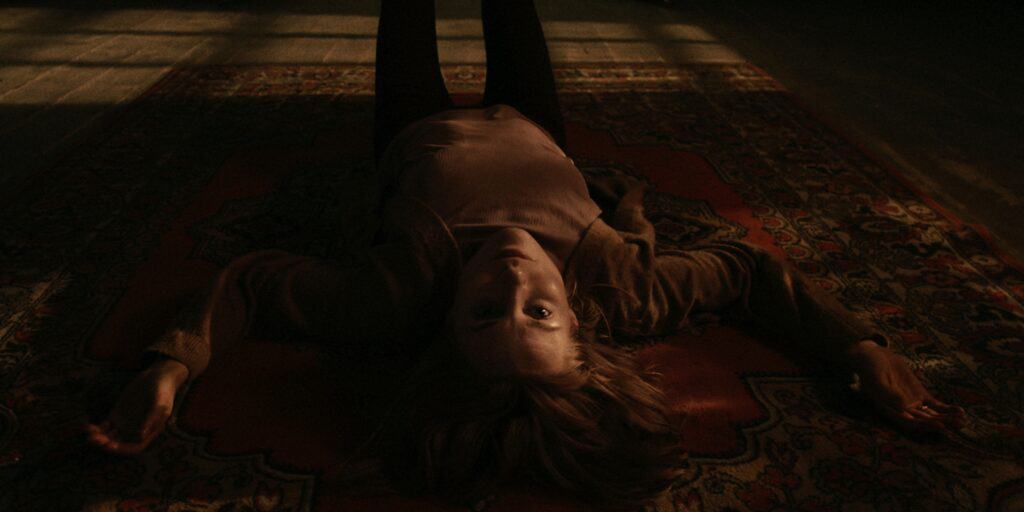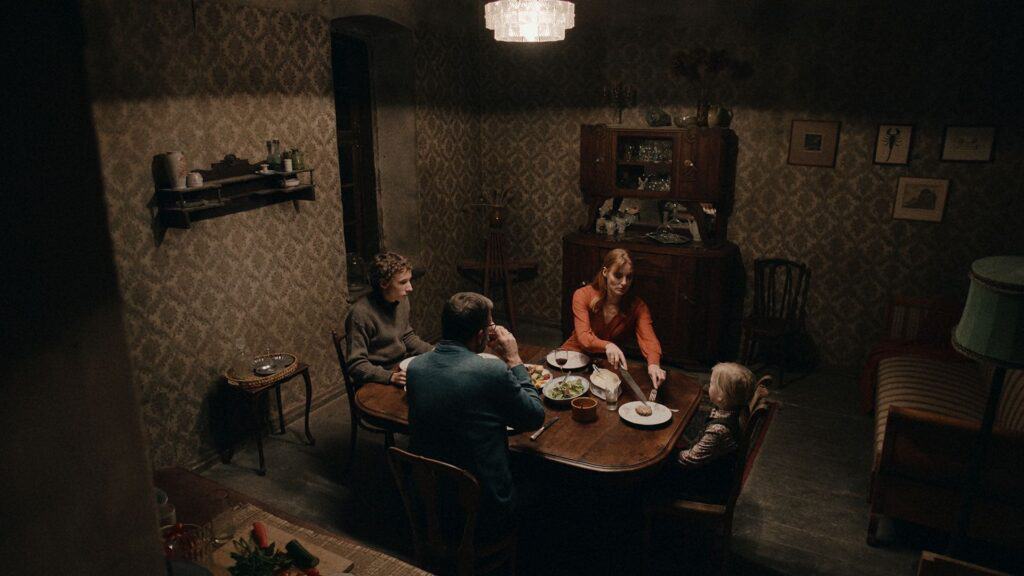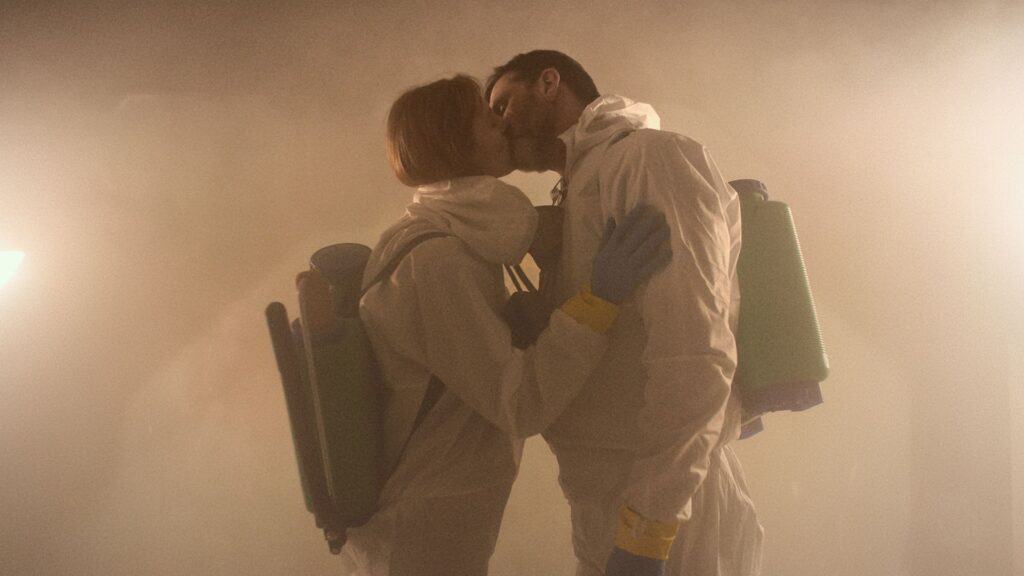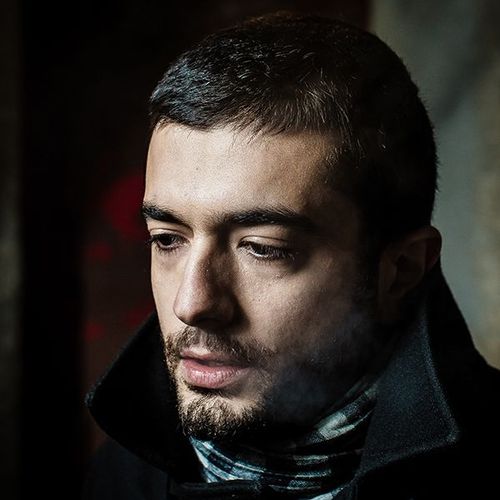I watched Aik Karapetian’s film The Brazen (Bezkaunīgie), reviewed here at the Black Nights Film Festival. I liked it so much that I immediately felt the need to talk to the director. He was only in Tallinn for a short time, but the marvellous staff at Black Nights made it happen already the next day. Thus, you can read my interview with Aik Karapetian.
I start as I always seem to do and ask what the genesis was for The Brazen.
During the summer of 2018, we were planning to celebrate Christmas. Then, suddenly, we noticed insects coming from the ceiling. Our children were quite scared, and we had to start fighting those insects. At that moment, I got the idea that this could be an interesting concept for a movie. A family struggling against insects to save themselves. That was the first trigger. Then, I started to think about how to produce the film. It was soon clear that the only way would be with a very small budget and in a single location.
You said that they are fighting the insects, but in some ways, they seem to fight each other as much as the insects, which almost becomes a metaphor for the situation.
I didn’t think about metaphors so much but more about the concept of how I could create a family drama but wrap it in a genre. To make a drama but with the ambience of a horror film.
Did you have any specific films in mind?
I was inspired by several films like Polanski’s The Tenant, Suspiria, but, Luca Guadagnino’s remake.

The remake? (Probably said with a disapproving smirk)
Yes, in terms of colours and the visuals in general. Also, Possession by Andrzej Żuławski.
I thought about that one when I saw it.
Yes, the film is about a divorce, but it’s shot as a horror film, and I thought it was a very beautiful way to tell a story.
The concept of the family is interesting here as well. The man and the wife are very different. He is more rational and almost authoritarian. He is also an academic. Meanwhile, Helena is into Zumba and more open to nature. I’m afraid to say this, but I felt like the father was like me, but I guess many viewers would regard him as the villain.
Actually, the reference to this character was Jordan Peterson.
In a positive or negative way?
Neither. I just thought it would be interesting with two characters who have very different perceptions of the world, and of course one is dominating. At one moment, there is a fight for domination in the family, and I was more focused on the transformation of Helena, the principal female character. How she’s transforming during these days in this house, I guess you noticed how she changed in the end; they are like two different characters. She became more brave.
When I was writing the script, the first idea was to make a family an allegory of the society, like a liberal and conservative kind of parts of society, and they’re trying to fight with each other with two very different mindsets. When it comes to nature, I believe that women are more close to nature than men are. At least in my family, for example, I do not enjoy nature as much as my wife does. Nature is not only a paradise, but it could also be like hell.
Yes, it’s a cruel place. Talking about creatures, you mentioned her transformation, I almost felt it was like a caterpillar turning into a butterfly.
Yes, yes, it’s a real transformation.

Talking about the husband, Richards he’s an intellectual, more precisely a professor in psychology, and the film is bookended by one of his lectures, and it’s about couples therapy. The story we see is one made up during that class. How did that idea come about?
The last scene was the key. I was not sure that it would work out. The story is in some way like a fairy tale. The exercise during the class felt like a good way to tell the story. When it comes to intellectuals one of the ideas was that that theory is different from reality, and what we would like to be is not always what we actually are.
The framing device, was that the way the script was structured from the beginning?
Yes.
Talking about the structure, you are using Honegger’s third symphony, which is a favourite of mine, and there is a structural resemblance between the symphony and the film.
With the three parts, yes
That was the intention?
Actually, it’s funny because it was my co-writer, Justīne Kļava, who came up with the idea for this Honegger symphony. I didn’t know about it before. I was very sceptical about this idea. Then, during the editing, I tried the music, and I found it very funny because it’s so over-the-top. That makes it a bit ironic with a theatre-like setting. It makes the story more unreal and, as I said, like a fairy tale.
One of my favourites, Manoel de Oliveira, did that in Le Couvent (1995), where, even in quiet scenes, he used dramatic music by Sofia Gubaidulina.
Stanley Kubrick did the same thing already in The Shining (1980).1 He used music by Bártok, Ligeti, and Penderecki.
I really like the cinematography in the film. I understand that the budget was relatively small, so how did you achieve this, and how did you approach this aspect together with your DOP?
We had a very short shooting period, 12 and a half days. I had worked before with Jurģis Kmins, my DOP in my previous film, Samuel’s Travels, a few years ago. I have known him ever since he was an assistant on The Man in the Orange Jacket, a slasher that I made like 10 years ago [2014]. Usually, we share photos and paintings with each other. We also made tests with the costumes, testing how to shoot the colour of the hair and so on. We knew we had to shoot very fast, And what helped a lot was that we had six days of rehearsal shooting with the actors and the camera on the actual location.

So you couldn’t do that many takes, then?
No, some scenes we made with only two takes, like the dinner scene. Those six rehearsal days were important since we knew we wouldn’t have time to discuss too much during the shooting. That went for the actors as well. They are not professionals, with the exception of Marta (Grase). It was a weird process to shoot eight pages per day. We all worked closely together, and I think it’s Kmins’ best work to date.
And which camera did you use?
We used a Sony Venice camera, and we used many zoom lenses. I love zooms, but I don’t like Steadicams or hand-held cameras. If you need some dynamic in the frame, the zoom helps a lot, especially to build tension or create a subjective kind of perception of the character, I love to do that.
So, how much work was needed for the colour grading?
Not so much, actually. We tweaked some stuff here and there. Jurģis was involved very closely in this process, and he controlled everything. I think he did a great job with the colour grading.
What about the editing process, considering you didn’t have so much time and money? Was most of it decided in advance?
I made an assembly cut, and then I sent it to a French guy for whom it was the first film. He made some changes, and we sent things back and forth. That was it. It was a very quick process.
So the film has already opened in Latvia. How was the reception there?
Very well, but at the same time, in Latvia, people are not used to watching genre films. People love to watch historical films. I really like to screen my films at genre film festivals where film geeks are used to this kind of stuff.
Do you have any new projects planned?
I have one project that I’m expecting to be greenlit in a few weeks. If so, I’m going to develop that idea, but I’m more focused on theater and opera. Next year, I’m expecting to stage my sixth opera production.
